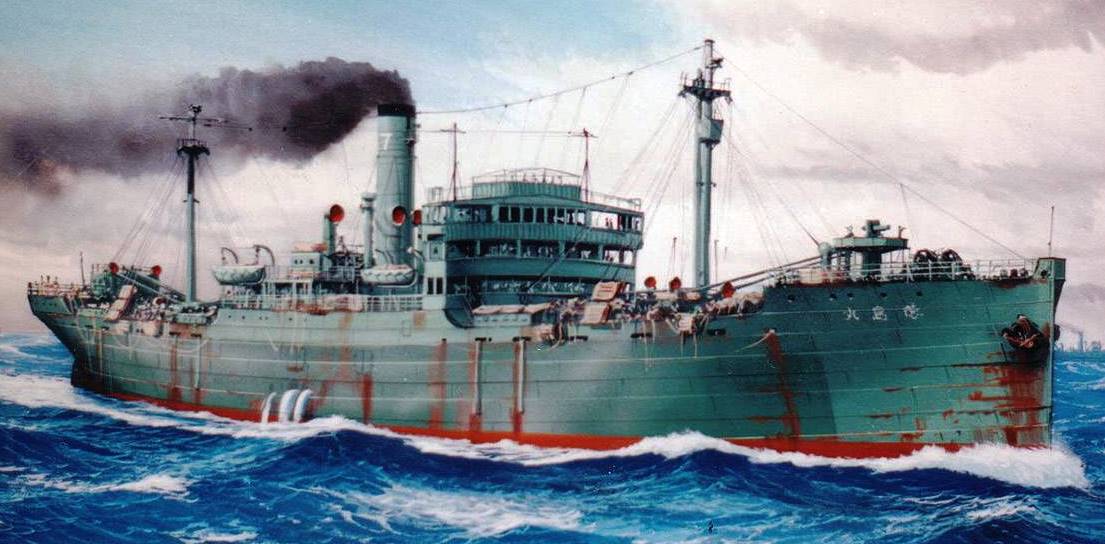RIKUGUN YUSOSEN
 (TOKUSHIMA MARU in wartime by Kihachiro Ueda)
(TOKUSHIMA MARU in wartime by Kihachiro Ueda)
TOKUSHIMA MARU:
Tabular Record of Movement
© 2018 Bob Hackett
E 1912:
Port Glasgow, Scotland. Laid down at Russell & Co, Ltd. as Yard No 648, a 6,054-ton
cargo ship for Nippon Yusen Kaisha (NYK Line) K. K. of Tokyo.
31 July 1913:
Launched and named TOKUSHIMA MARU.
1913:
Completed.
1913-1937: In NYK's service.
15 July 1937: Second Sino – Japanese War.
Requisitioned by the Imperial Army (IJA) as a troop transport. Allotted IJA No. 62.
26/3/38 .
3 November 1937:
TOKUSHIMA MARU departs Goto Islands in a convoy also
consisting of ALASKA, BUZEN, ENGLAND, GYOKO, HAKODATE, INDUS, KAISHO, KOSHIN, MINAMOTO, SANDAI. SHINTAN, SHOKYU, SHUNSEI, SUEZ, and ZENOAH MARUs escorted by
destroyer YUZUKI.
5 November 1937:
Arrives at Hangzhou Bay, China and lands troops.
26 March 1938:
Released by the IJA back to her owners.
3 August 1940:
Re-requisitioned by the Imperial Army (IJA).
19 February 1942: The Invasion of Eastern Java:
Jolo, Philippines. At 0800, the Eastern Java Invasion Convoy (Toho Koryaku Butai) consisting of 39 troop transports departs the anchorage carrying the IJA’s 48th Infantry Division in seven sections:
1st Section consisting of: HAGUE, YAMAGIKU, KENKON, NANKO, ADEN and KONAN MARUs,
2nd Section consisting of: HOLLAND, JOHORE, TAKAOKA, HOKKO, KYOKUSEI and TAEI MARUs,
3rd Section consisting of: KENZAN, HIMALAYA, HAVRE, ARIZONA, ANZAN and CHOKO MARUs (6783/20),
4th Section consisting of: NISSHU, BIYO, ITALY, ASAKA, KASHU and YONEYAMA MARUs,
5th Section consisting of: TOKUSHIMA, HAKUSHIKA (HAKUROKU), TEIYO, HAMBURG, DENMARK and ARABIA MARUs,
6th Section consisting of: MIYADONO, JINZAN (JINSAN), WALES, SUEZ, TAMON and YASUKAWA MARUs, and the
7th Section consisting of: SATSUMA, MINRYU and HOZUGAWA MARUs.
The convoy is escorted by Rear Admiral Nishimura's heavy cruisers NACHI and HAGURO, DesRon 2's light cruisers NAKA and JINTSU and DesDiv 16's YUKIKAZE, TOKITSUKAZE, AMATSUKAZE and HATSUKAZE and DesDiv 7's USHIO, SAZANAMI, YAMAKAZE
and KAWAKAZE and DesRon 4's light cruiser NAKA, DesDiv 2's YUDACHI, SAMIDARE, HARUSAME, DesDiv 9's ASAGUMO, MURASAME, MINEGUMO and NATSUGUMO.
E 21 February 1942:
Makassar Strait. SAGAMI and SASAKO MARUs join the main convoy and steam with it.
22 February 1942:
At 1200, EHIME and LIVERPOOL MARUs join the Eastern Java Invasion Convoy north of Aru Bank. The same day, HITERU and TEIRYU MARUs depart Palau carrying elements of the Sakaguchi Detachment.
23 February 1942:
HITERU and TEIRYU MARUs join the Eastern Java Invasion Convoy.
27 February 1942: The Battle of the Java Sea:
At 1547, HAGURO and NACHI, DesRon 2's JINTSU with DesDiv 16's
YUKIKAZE, TOKITSUKAZE, AMATSUKAZE and HATSUKAZE and DesDiv 7's USHIO, SAZANAMI,
YAMAKAZE and KAWAKAZE engage Dutch Rear Admiral Karel W. F. M. Doorman's Strike Force's light cruiser Hr.Ms. DE RUYTER (F), heavy cruisers HMS EXETER and USS HOUSTON (CA-30), light cruisers HMAS PERTH and Hr.Ms. JAVA, destroyers HMS ELECTRA, ENCOUNTER, JUPITER, Hr.Ms. KORTENAER and WITTE de WITH and old destroyers USS ALDEN (DD-211), JOHN D. EDWARDS (DD-216), JOHN D. FORD (DD-228) and PAUL JONES (DD-230).
During this day and the next day’s engagements, Doorman's Strike Force loses HMS EXETER and USS HOUSTON (CA-30), light cruisers HMAS PERTH, HrMs DE RUYTER, Hr.Ms. JAVA, destroyers HMS ELECTRA, ENCOUNTER, JUPITER and Hr.Ms. KORTENAER to superior Japanese forces. The Allies also lose old four stack USS POPE (DD-225).
1 March 1942: Operation "J" - The Invasion of Java, Netherlands East Indies:
At 0120, 100 miles W of Surabaya, Java. The Eastern Java Invasion Force now consisting of 43 transports including TOKUSHIMA MARU enters the roadstead off Kragan village, East Java.
Just before dropping anchor, the ships suffer a fierce air attack. JOHORE MARU is hit and suffers many KIA and WIA. TOKUSHIMA MARU is also hit and has to be beached at 0200. Despite the air attacks, at 0015, the convoy lands the 48th Infantry Division at Kragan village, East Java. Their main objectives are the Surabaya Naval Base on the eastern coast and Tjilatjap harbor on the southern coast.
9 September 1944:
At 1600, TOKUSHIMA MARU departs Manila for Takao, Formosa and Moji, Japan in convoy MI-14 also consisting of ENOSHIMA, MIHO, KEISHU, KENSEI MARUs and oilers ATAGO, OGURA MARU No. 2, and TOKUWA MARU escorted by kaibokan CD-14, patrol boat
P-38 and subchaser CH-20. En route north, minesweepers W-38 and W-39 join the escort.
16 September 1944:
At 0440, departs Basco Bay, Batan Island, Philippines.
Bashi Channel. At 1355, LtCdr (later Vice Admiral) Glynn R. Donaho‘s USS PICUDA (SS-382) fires for torpedoes and gets three hits that sink TOKUSHIMA MARU at 21-27N, 121-35E. She was carrying 112 passengers and 5,400 tons of chrome ore. 82 passengers, 52 crewmen and 44 gunners are KIA.
The explosion damages nearby oiler OGURA MARU No. 2. She stops for repairs, but at 1515, LtCdr (later Rear Admiral-Ret) Louis D. McGregor's (USNA ’30) USS REDFISH (SS-395) torpedoes and sinks OGURA MARU No. 2 at 21-42N, 121-41E. 23 passengers, 3 armed guards and 15 crewmen are KIA.
Author's Notes:
Thanks go to Erich Muehlthaler of Germany.
Bob Hackett
Back
to IJA Transports





